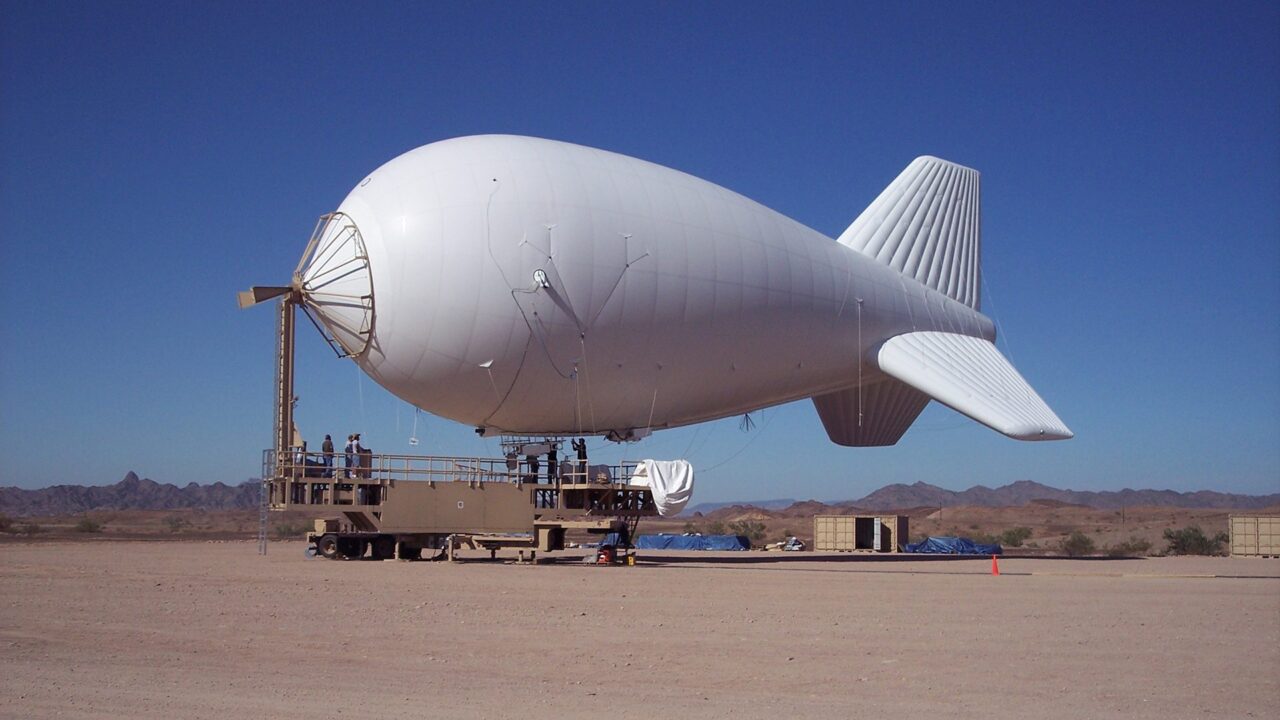The US Military Has Used Illegal Spy Balloons for Decades
There is a long history of aerial reconnaissance competition between the United States, Russia and the Soviet Union, and the People’s Republic of China. US soy baloon by Lockheed Martin via Lockheed Martin / CC BY-SA 3.0
US soy baloon by Lockheed Martin via Lockheed Martin / CC BY-SA 3.0
On Feb. 4th the United States shot down a Chinese high-altitude balloon after it sailed over the United States over the course of several days. The Biden administration claimed it was a surveillance balloon, while the Chinese government called it an “unmanned civilian airship used mainly for meteorological research purposes” that had strayed off course due to weather conditions. US Press Secretary Karine Jean-Pierre said the balloon was a “clear violation of our sovereignty as well as international law…”
The White House and most American media have positioned the Chinese balloon as a serious and unwarranted act of aggression by the Chinese government. The reality is that this incident is just one chapter in a long history of aerial reconnaissance competition between the United States, Russia and the Soviet Union, and the People’s Republic of China dating back to the early days of the Cold War. Whether or not the Chinese balloon was designed for reconnaissance, the key context the Biden administration is neglecting to mention is that the US military invented the modern spy balloon and has used them hundreds of times, including over Chinese airspace. In fact, in an almost exact reversal of this month’s event, the Chinese military shot down an American balloon in 1974 they also claimed was a surveillance aircraft.
Aerial reconnaissance, including surveillance balloons, have become a lodestone of American military power since WWII, after which American military doctrine increasingly shifted towards “air power” in which warfare centers not on traditional armies but on high tech aerial combat, surveillance, and precision bombing. This doctrine was encouraged by perceptions of the unique threat posed by the Soviet Union among military leaders. The USSR supplied an enormous military from within a huge country, one in which key military infrastructure could be hidden in the massive steppes, desert, thick forests, and taiga of the Soviet interior about which American intelligence knew little. Thinking that the answers to combatting this enemy lay in the skies, a number of American scientists and military leaders turned to the technological programs of the defeated Axis powers, including Japanese incendiary war balloons and the Nazi V2 missile program, helped by adopted experts from defeated Germany and Japan.

In the 1940s and early 50s the US military flew bombers refitted with cameras around the edges of Soviet airspace, including short trips over the country when air defenses seemed thin, but this was both illegal and highly dangerous. Frustrated by the lack of Soviet intel, certain leaders within the American military intelligence and the CIA increasingly turned towards high tech balloons, spy planes, and spy satellites as the solution to their reconnaissance problem.
In 1956 the US Air Force started flying reconnaissance balloons over the Soviet Union, East Bloc, and China meant to capture photos of the communist “target system,” including both military bases and civilian industrial, transportation, and economic infrastructure. This project, “Project Genetrix,” was given the highest national priority of 1-A, a status only shared by the hydrogen bomb.
A total of 448 Genetrix reconnaissance balloon flights were launched between January 10th and February 6th of 1956, with as many as 40 balloons launched a day. The vast majority did not survive, either shot down by aircraft or lost to inclement weather. The photos recovered from the balloons covered over 1.1 million net square miles of Soviet and Chinese territory, equivalent to 37% of the continental United States. In a simultaneous attempt at psychological warfare, the Free Europe Committee (a CIA front group) flew balloons over the Warsaw Pact countries that dropped hundreds of thousands of propaganda leaflets.
Not only was this balloon program a flagrant disregard of the national sovereignty of a dozen or so countries; it also stood in stark opposition to the international agreements the US was proposing to the USSR at the very same time. While President Eisenhower was conducting Genetrix (what he admitted privately was a “dirty trick”), he was attempting to convince the Soviet leadership to agree to his Open Skies Proposal, which would have granted both countries the right to openly and freely aerially survey each other’s territories as an act of good faith and in order to discourage military buildup and clandestine spy programs.
These balloons were meant to poison, plague, and terrorize a Soviet society in which the largest cities had already been incinerated and densely populated areas severely irradiated.
The military thinkers behind Genetrix also had interests beyond simple reconnaissance. These surveillance balloons were made to be interchangeable with balloons to be used in wartime, code named operation “Flying Cloud,” which were designed for psychological warfare (carrying propaganda leaflets, counterfeit money, and fake ration coupons) and as weaponry. Designers came up with a number of weaponized balloons included incendiary balloons (taken right from the Japanese playbook); as well as balloons carrying chemical or biological weapons like nerve gas, herbicides, or anthrax spores; and balloons carrying human diseases like smallpox and yellow fever or crop and livestock diseases like wheat and potato blight, foot and mouth disease, or hog cholera. Some of the disease balloons were designed to release infected insects and small animals. As nuclear war increasingly seemed like a likely future if World War III ever broke out between the US and the USSR, these war balloons were to be used in what military thinkers called a “Broken Back” phase in which both countries would engage in traditional warfare after a nuclear exchange had already devastated both countries.
In other words, these balloons were meant to poison, plague, and terrorize a Soviet society in which the largest cities had already been incinerated and densely populated areas severely irradiated. Testing for the Flying Cloud project stopped once both the United States and the Soviet Union had successfully tested the hydrogen bomb, a thousand times more powerful than early atomic bombs. After that there was no longer interest in war balloons given that society would presumably cease to function once the entirety of the Soviet Union had been either obliterated or contaminated by fallout.
In early February of 1956, the Soviet government publicly protested the flagrant violation of their airspace by American balloons clearly designed for aerial reconnaissance and psychological warfare. Public exhibitions were held in China, the Soviet Union, and in the East bloc of captured American balloons, including camera and radio equipment.
The US Air Force replied that the balloons were in fact part of a “meteorological survey.” They even asked the Soviet Union to politely return the balloon gondolas that had “come into its possession.” They did agree to avoid launching additional balloons that “might transit the USSR” in the future. Despite the discovery of the program and the public controversy, the Air Force continued to plan future Genetrix flights, aiming to overcome enemy air defenses by either only flying special high-altitude balloons at 80,000 ft, well past the reach of aircraft, or by simply flooding communist air space with all of the 2,500 balloons that were waiting to be deployed in a blitz tactic.
Ultimately the White House turned down these plans and shut down project Genetrix on March 1st, 1956, almost a month after it had publicly promised to not continue the balloon flights. Yet, the cancellation of Genetrix wasn’t done out of a good faith effort to stop illegal reconnaissance but rather because better reconnaissance spy planes and satellites were ready to take their place.
Spearheaded by the CIA and with support from the DOD, the US had begun to conduct aerial reconnaissance of the Soviet Union, China, and a number of other countries using the high-altitude U-2 spy plane earlier that year. The cover story for the U2 was that it was a scientific program designed for sensing high-altitude weather conditions conducted by NACA (and later its successor agency NASA). Flying at over 70,000 ft. well out of the range of enemy fighters, the U-2 at first seemed safe when Eisenhower approved the first flights in January 1956.
However, Soviet radar capabilities were far better than anticipated. Khrushchev was notified about the first U-2 flight and had the Soviet ambassador in DC protest the violation of Soviet airspace the very same day. Maintaining that these were simply scientific flights that were not entering communist countries’ airspace, the U-2 flights continued for several years semi-regularly with Soviet fighters trying in vain to reach them.
Finally on May 1st, 1960, the Soviet Union shot down a U-2 flown by pilot Gary Powers using a new surface-to-air missile deep within the Soviet Union. Initially thinking Powers was dead, NASA announced that one of its high-altitude research flights over Turkey had gone missing and may have accidentally drifted across the Soviet border. A few days later, Khruschev announced that Powers was in fact alive and had already confessed to spying on the Soviet Union. The U-2, still largely intact, made it undeniable this had been a military reconnaissance operation. This caused an international incident that culminated with Eisenhower publicly admitting the program’s existence, but refusing to apologize to the Soviet Union at the Paris Summit a few days later, which promptly collapsed.
U-2 flights over the Soviet Union ceased but continued over other countries including over China and Cuba. A number of U-2s were given to Taiwan to conduct reconnaissance over China, flying a total of 220 missions between 1959 and 1974, 2 of which were shot down. Later generations of the U-2 are still in regular service for American military surveillance.
The Biden administration would have you believe that the Chinese balloon debacle is symptomatic of an increasingly aggressive Chinese state poking for weaknesses in American national security. It is true that we live in an era of surveillance in which all major countries engage in various forms of espionage against their perceived enemies and even allies. But when it comes to aerial reconnaissance, the United States has paved the way, constantly pioneering new and better forms of surveillance. Its attitude has been to flout international laws regarding airspace abroad while demanding their enforcement at home. The People’s Daily, the official organ of the Chinese Communist Party, claims that 10 high-altitude balloons from the United States have flown over Chinese airspace since the beginning of 2022 alone, an allegation the US denies.
The media blitz that the Biden administration has incited around the balloon isn’t an isolated event. Rather, it’s part of a long pattern of hypocrisy in US criticism of other nations with roots in the Cold War. This trend is particularly common with aerospace technology. For instance, there was a flurry of US state and media criticism of anti-satellite weapons tests by China in 2007 and by Russia in 2021. Such tests are extremely dangerous because they produce tens of thousands of bits of space debris that can damage other satellites. Potentially such tests can even lead to a “Kessler effect” in which debris from one destroyed satellite takes out other satellites and the debris from that even more satellites in a cascading effect that could destroy most or all of space infrastructure and lock humanity under a halo of space junk. Yet what state officials and pundits neglect to mention is that the US has been developing the same technology since the 1950s and has successfully tested it in 1985 and 2008. Vice President Kamala Harris committed the US in 2021 to not testing such weapons. Of course, the US military doesn’t need to test them because it already has them and maintains them as an active part of its arsenal. A more beneficial and genuine commitment would have been to not use anti-satellite weapons entirely. What the US government paints as aggression is often other countries catching up to its own aggressive technologies.
The many important scientific goals to be explored in the upper atmosphere and in outer space are worth pursuing in their own right, not as the cover for or secondary benefit of the military and its pernicious interests.
The point of these intentionally generated international incidents centered on military technology isn’t just to increase public ire towards foreign countries but to provoke public support for the expansion of the very same technologies. In recent years the US military has returned to its spy balloon program, designing new, high tech balloons with autonomous navigation and on-board AI capable of releasing swarms of drones. Only days after stoking public anxiety about the Chinese balloon, military officials and politicians on both sides of the aisle started clamoring for more funding for aerospace surveillance technology.
This media strategy is a Cold War-era tactic tried and true with support from much of the liberal media establishment. Seemingly satisfied with the public scandal generated by the balloon incident and looking to further test the waters, the Biden administration approved the shooting down of three other UFOs over Alaska, Canada, and Lake Huron which were “most likely balloons tied to private companies, recreation, or research institutions,” but it could not be ruled out “the surveillance risk of sensitive facilities.”
At the core of this balloon incident and the increasing tensions between the superpowers is the ambiguous line between “science” and the “military” in aerospace technology. Was the Chinese balloon a science vessel or for military reconnaissance? The reality might fall somewhere in between. In aerospace research, military interests and scientific goals often go hand-in-hand. Project Genetrix’s cover story was a scientific balloon program designed to study high altitude conditions called “Moby Dick.” The U-2 plane was introduced as a NASA weather research vehicle. Even one of the United States’ first scientific satellite programs was in fact an elaborate cover story for the CORONA program, the world’s first spy satellite system, which operated until 1972.
But the ambiguity between scientific and military research goes deeper than cover stories. Reconnaissance data generated by these and other programs has had serious scientific benefits. Without secret funding for military reconnaissance, we might not have such sophisticated satellites, GPS data, mobile phones, and such extensive knowledge of climate change. Many of the “spinoff” benefits of space and upper atmosphere technology we enjoy today came from military reconnaissance.
But it doesn’t need to be like this in the future. The many important scientific goals to be explored in the upper atmosphere and in outer space are worth pursuing in their own right, not as the cover for or secondary benefit of the military and its pernicious interests. If the Biden administration was genuinely interested in reducing tensions with China, it would 1) disentangle scientific aerospace pursuits from military interests; 2) internationalize aerospace research so that all nations can participate and benefit from shared knowledge of meteorology, climate, and space; and 3) liberalize the aerospace sector rather than continually make it more classified (a worrying trend in the past few years). Increased secrecy only leads to increased efforts at surveillance. During the Cold War, uncovering data that upset the alleged “bomber gap,” “missile gap,” and other political chicanery never reduced tensions; it only led to further anxiety and the acceleration of the arms race. The war of surveillance has always been a fool’s errand, and an incredibly costly one at that.
Your support matters…Independent journalism is under threat and overshadowed by heavily funded mainstream media.
You can help level the playing field. Become a member.
Your tax-deductible contribution keeps us digging beneath the headlines to give you thought-provoking, investigative reporting and analysis that unearths what's really happening- without compromise.
Give today to support our courageous, independent journalists.






You need to be a supporter to comment.
There are currently no responses to this article.
Be the first to respond.